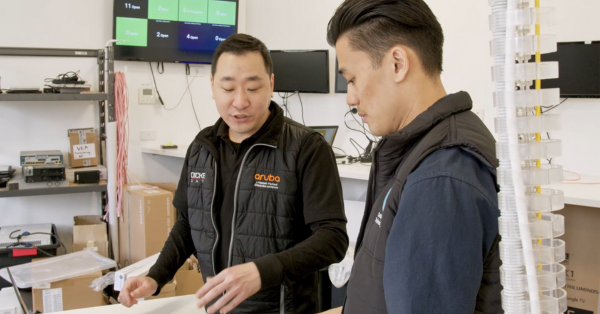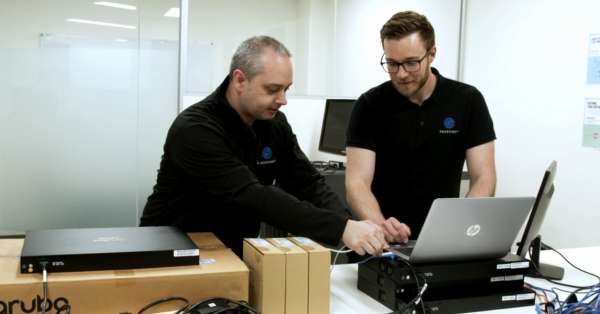With remote working the new reality for many Australian businesses, the bandwidth and security of corporate and Internet of Things networks matters more than ever before. Australia’s peak body for the Internet of Things already predicts rapid increases in the need for IoT’s real-time, remote data management capabilities as a result of Covid-19, which has also accelerated digital transformation to the point that many enterprises need significantly greater bandwidth and network resilience – and fast.
That makes Wi-Fi 6, the latest standard of the technology to be rolled out, incredibly relevant to enterprises today – perhaps even more than any previous release. In this post, we’ll look at Wi-Fi 6’s implications for enterprise networks and assess how Aruba’s access points, some of the first officially certified Wi-Fi 6 solutions to arrive on-market, address some of the key networking concerns Australian businesses currently face.
Wi-Fi 6: what you need to know
The 802.11ax standard – Wi-Fi 6 to most – was designed to tackle two of the most critical issues in Wi-Fi networks today: performance and bandwidth. Wi-Fi 6 brings with it as much as 4 times more throughput capacity than Wi-Fi 5 (802.11ac), while allowing concurrent access to 2.4 GHz and 5 GHz frequencies in a range of use-cases. The standard also packs a range of new features including OFDMA (Orthogonal Frequency Division Multiple Access) which, in simple terms, can serve devices with different bandwidth needs at the same time – effectively eliminating competition to send data through the network.
The result: higher performance, for a higher density of devices and diversity of applications. That includes the Internet of Things, which Wi-Fi 6 caters to with specific operating protocols for low-power, low-bandwidth devices as well as features like Target Wake Time – which only wakes up devices when it’s their scheduled turn to transmit data. Both its IoT friendliness and the raw performance gains that it offers should endear Wi-Fi 6 to businesses looking at far more automated operations and distributed workforces.
What does Aruba offer?
Aruba’s solutions include some of the first Wi-Fi 6 indoor access points to arrive on market: to date, the Aruba 500 Series, 510 Series, 530 Series and 550 Series access points have all received Wi-Fi 6 certification. Aruba’s AI-powered wireless software on its access points also packs a range of features designed to maximise on Wi-Fi 6’s potential, including:
- AirMatch, which optimises the access point’s channels, bandwidth, and power using machine learning for a much more consistent user experience;
- Smart power monitoring, which allows access points to shut down specific device features when necessary to support lower-power restrictions on certain switches; and
- Heightened security, with WPA3 and Enhanced Open baked into Aruba’s access points for stronger credentials handling, even on open networks.
Aruba’s Wi-Fi 6 solutions take full advantage of the standard’s capabilities like OFDMA and multi-user features. The Aruba software’s AI components also lend themselves to more efficient Internet of Things use cases, reducing the need for manual intervention and ongoing maintenance of devices and their bandwidth consumption. That’s a huge benefit for enterprises looking to take greater advantage of IoT and automation whether in response to current restrictions on worker movements and travel, or increasingly mobile and dispersed workforce movements in the future. Enterprises may also want to consider deploying Aruba access points to support employees with high-bandwidth, high-security requirements for their homes, enabling a massive step up in productivity and engagement at a relatively affordable cost and speed of deployment.
Is Aruba’s range of Wi-Fi 6 solutions a game-changer? It certainly offers a resilient option for enterprises seeking to rapidly upscale their access network infrastructure, particularly those considering substantial increases in their Internet of Things footprints. Aruba’s Wi-Fi-6 range of access points, in conjunction with Aruba Central (the vendor’s cloud-based Network Management Platform) should form an integral part of ongoing discussion around digital infrastructure and capability for their businesses. After all, it’s not just the latest standard for Wi-Fi – it’s what businesses in a digital world need more than ever before.
If you need help in designing a Wi-Fi 6 solution, tap on the Dicker Data Networks Team’s expertise in hands-on wireless network design by emailing aruba.presales@dickerdata.com.au









